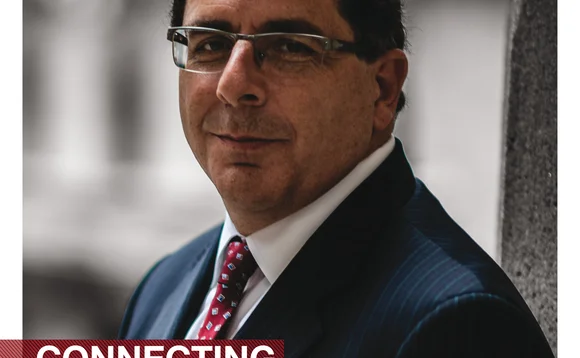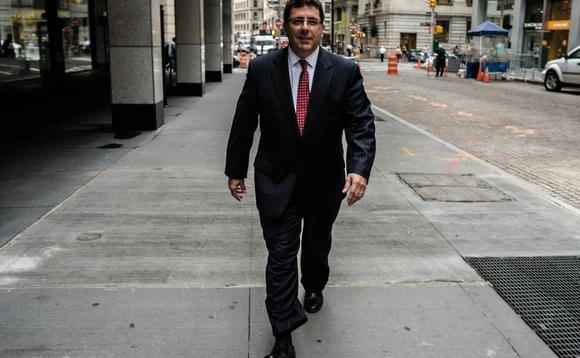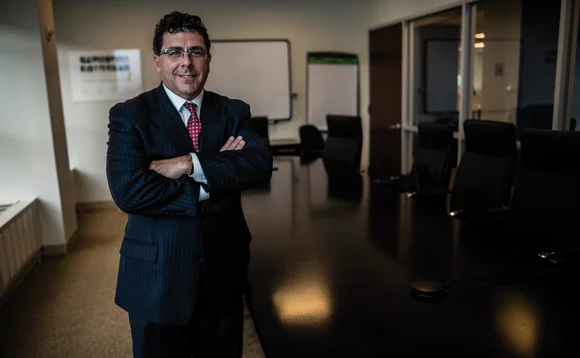Guggenheim's Joseph Lodato Pulls Tech, Compliance Together






Karate is all about movement, about flow. You have to perfect one discipline, one move, one combination, before you can move on to the next.
Joseph Lodato took up taekwondo when he was a junior in high school. He wasn’t tall enough for basketball, and baseball was a bit too bland. Taekwondo served as the best way to release some energy. Over the next 35-plus years, he has perfected a continuous stream of techniques and movements, rising from a white belt to a 7th-dan black belt.
Lodato’s path to Guggenheim Securities, where he serves as the investment bank’s chief compliance officer, has taken on something of a similar course. While the role of CCO is often rooted in law, Lodato’s career spans operations, compliance and technology at financial services firms.
Randy Abernethy, then the CEO and CTO at UNX, gave Lodato his first big break in technology in 2000. Abernethy hired Lodato as UNX’s COO because of his strong character and the fact that he was no pushover. Also, he was well-rounded.
“I don’t see Joe as a compliance guy—I see him as a highly talented financial firm exec,” Abernethy says. “He wanted to see the technology work and he wanted to make sure that everyone knew how to run things under duress. He really cared about risk but did something more than just complain about it. If we took the time to build it, Joe would make sure that it worked and actually added value. He knew our business and he knew what the technology needed to do.”
“It’s like school. If the school has a uniform policy and you come to school not wearing your tie—you must not want to be at the school. There’s no detention … either you want to be here, or you don’t. As an investment bank, we have a brand; we have clients who trust us.”
Perfect Strangers
Talk to most any head of technology and they’ll lament the fact that since the financial crisis—and the subsequent implementation of the Dodd–Frank Act—compliance and regulatory issues have dominated their IT spending (see page 30). Rather than investing in sexy, innovative trading platforms, they’re more concerned with reporting requirements and data warehousing. Tick the box and move on.
Lodato realized early on that if he wanted to be in compliance and operations, he had to understand technology better. Yet he feels this is not the standard on Wall Street when it comes to compliance.
“There has to be communication between compliance and technology, but there’s still not good communication. I don’t know many chief compliance officers who can understand the technology side,” Lodato says. “When I was running operations, I had to trust technology. Unfortunately, there’s a lot of inertia. CTOs are not paid to break everything they’ve got and redo it from scratch for a better platform. So after five years, the tech is getting stale, and there are all these patches and operational risks. They don’t want to trash it all and redo it; they are just trying to keep the momentum. On the other hand—and this is just what I’ve seen—compliance officers don’t know how to develop and build technology, so they build silos and that’s the last thing you want to do.”
When Lodato arrived at Guggenheim Securities—the investment banking arm of Guggenheim Partners, a $210 billion buy-side giant—in March 2013, he tried to engender an air of cooperation between compliance and technology.
As a chief compliance officer, Lodato has to take in a large amount of information and follow it. He has to put the pieces together—connect the dots—from customer and employee trading, to deals, to communications in chat rooms and via email.
Lodato doesn’t want disparate databases and a swath of platforms built to deliver this information. He would rather use the infrastructure at the firm as the business would use it, rather than creating separate regulatory-specific platforms.
“Compliance doesn’t supervise—supervisors supervise,” he says. “Part of my job is to get them the information they need, and it happens to be the same information I use, just a little different as to the patterns we’re looking for. I need to take a lot of information from disparate places and bring it together. Typically, technology has been built in silos. They keep the silos and make a bus or a bridge to deliver that information, but then they start doing the multiple-to-multiple, which takes a lot of infrastructure and you lose speed and accuracy.”
The Long and Winding Road
After five years of studying to be a doctor, Lodato decided to change his career path and found himself at Chemical Bank. At 25, he headed its bond redemption unit. He went to night school and worked toward his BBA in finance at Pace University, while also serving a brief stint at Bank of New York, where he worked after Chemical.
Lodato received his degree in 1988 and went to work for a friend in upstate New York at a broker-dealer advisory firm, and this is where he got his first taste of compliance. He parlayed this experience into a branch examiner role at what was then known as Shearson Lehman Brothers.
This was an interesting time for Lodato, as a year-and-a-half into the job, he was assigned to Lehman’s notorious 55 Water Street branch. In 1992, the Los Angeles Times called the brokers at the firm “unethical” in a scathing 4,000-word exposé of the office. It was quite the learning experience, and it helped Lodato land his next position.
He added operations to his resume at Montgomery Securities—which was acquired by NationsBank, which in turn acquired BankAmerica and took on the name Bank of America—where he became director of equity operations for Banc of America Securities.
While he had always worked alongside technologists while in operations, Lodato says he had to largely take their word when the CIO or CTO said that they needed something. That’s what led him to UNX, a Burbank, Calif.-based independent trading technology firm and agency broker, which launched in late 1999.
In November of the following year, Lodato was brought on as its COO. There, he had to learn about business-continuity planning and how datacenters worked. He ran failovers between UNX’s primary and back-up sites while focusing on people and the “big picture” to ensure platform reliability and customer satisfaction, according to Abernethy, who is now the managing partner at trading platform provider RX-M.
“There are three legs to the stool: business, technology and compliance,” he says. “If you don’t have all three, you fall down. Moreover, if your compliance team doesn’t understand the tech or how the tech can be used to fulfill their mandate, you are going to be greatly disadvantaged and probably out of compliance as well. It is also important to make sure that compliance understands the business. I have seen compliance people who don’t understand order-routing logic try to make changes that would hurt customers in the name of compliance. This will not happen on the watch of a compliance officer who understands the business and the tech, and Joe understands all three legs of the stool.”
Lodato left UNX in 2004 to move back to New York with his wife, who was pregnant at the time with their first child. From there, he served his second stint at Lehman, this time as senior vice president and director of compliance, until its collapse in 2008. He then moved over to Barclays Bank, as director of its compliance supervisory group, where he spent the next 20 months helping with the transition after Barclays bought the carcass of Lehman’s North American trading operations. He bounced back over to operations after his stint at Barclays, as AllianceBernstein’s COO of trading. After two years at the New York-based asset manager, he signed on as Guggenheim’s CCO.
The Need for Innovation
Compliance officers are often considered hall monitors, and while Lodato understands that perception, he counters that compliance is not adversarial at its core. There could come a time when it would be his job to protect the company from a malicious individual or group of individuals, but the majority of his job is simply ensuring that a trader or manager doesn’t do something accidentally that would get them fired or tarnish the firm’s reputation.
Lodato recalls that Shearson Lehman Brothers had to move out of its 55 Water Street office in order to make a clean break from the previous administration. Similarly, if something goes awry at Guggenheim Securities, it hurts the Guggenheim Partners brand, and vice-versa. It can’t feel like a police state when trading inherently requires a certain level of risk taking. So it’s not crime and punishment—it is balance through oversight.
“It’s like school,” Lodato says. “If the school has a uniform policy and you come to school not wearing your tie—you must not want to be at the school. There’s no detention … either you want to be here, or you don’t. As an investment bank, we have a brand; we have clients who trust us. We have to live up to that trust. Either you do the things that live up to that trust or you don’t, and if you don’t then you don’t want to be here—just leave.”
Lodato believes that technology underpins compliance to a large extent and that compliance can’t be managed without technology. He acknowledges that with all the regulation that exists today, it’s tough to find that collaborative dynamic, but that’s also why he spends a lot of time interacting with technology—“to make sure the trader’s behavior is compliant, as well as efficient,” he says.
You might think that a head of compliance would be conservative when it comes to technological innovation, but Lodato is not. He attributes this in part to his days in the field of medicine, an industry he is still a part of by virtue of his position as the director of Lutheran HealthCare’s board of trustees.
Technology is revolutionizing the way that doctors diagnose and treat patients. Currently, major technology companies are focusing much of their investment dollars on health care-related projects. Lodato believes those giants, and others, will eventually start to focus on finance.
“It’s amazing what we can do remotely,” he says. “We have so much intelligence that’s being poured into a phone, but we should be doing so much more when it comes to analyzing real-time risk that’s delivered right to your iPad. Apple, Google and Amazon are going to get into this. Right now they’re looking at health care because there’s much-needed change that’s coming in to how health care is delivered. Once they do that, the only thing left is finance.”
Does he believe that vendors are ready—and willing—to participate in and collaborate on the coming revolution?
“Are the vendors ready to change themselves? I venture to say that they’re not,” he says. “I don’t see the innovation coming out. I don’t see a group on the side trying to figure out the next best thing. They’re still focused on penetrating the market with their platforms and battling the customer service issues. Some are doing it better than others, and some don’t care and literally focus on market share and not customer service.”
Lodato wants more innovation in finance. He doesn’t want to see compliance consume all the resources that used to go into research and development of new products. As firms struggle to do more than tick the box, regulation is driving up costs and the result is less innovation.
To combat this, Lodato believes capital markets firms need to be a bit more daring in terms of how they approach platform and infrastructure overhauls.
“The CTO or CIO is probably focused on this year, next year and keeping everything running,” Lodato says. “But what if I said, as a CTO, I know where I’m going to be in five years, and I’ll need a refresh? How do I do that? Maybe I say that I’m going to go and rent infrastructure, knowing that it’s going to be standardized for a specific firm, because they have to be ‘special.’ So I can rent a platform, get my best-and-brightest to trash the legacy system, use the rented system as a fill-in, and then leapfrog the competition with an innovative new platform. That’s risky. That’s daring. But that is what you need to do.”
Yes, he’s a compliance guy, but he knows the technology well enough to be dangerous. He’s the new breed of compliance officer.
Fundamental Data
Name: Joseph Lodato
Age: 54
Education: BBA in finance from Pace University’s Lubin School of Business.
Sensei: Lodato, a 7th-dan (degree) black belt, and his wife, a 3rd-dan black belt, are starting a taekwondo clinic at the Rye Brook Recreation Center in the suburbs of New York City. Their two children have also recently taken up taekwondo.
What gets him up in the morning: Managing people and putting them into the right position to succeed.
What keeps him up at night: Making sure he doesn’t miss something that will undermine his ability to protect the company, or a trader making a mistake.
Only users who have a paid subscription or are part of a corporate subscription are able to print or copy content.
To access these options, along with all other subscription benefits, please contact info@waterstechnology.com or view our subscription options here: https://subscriptions.waterstechnology.com/subscribe
You are currently unable to print this content. Please contact info@waterstechnology.com to find out more.
You are currently unable to copy this content. Please contact info@waterstechnology.com to find out more.
Copyright Infopro Digital Limited. All rights reserved.
As outlined in our terms and conditions, https://www.infopro-digital.com/terms-and-conditions/subscriptions/ (point 2.4), printing is limited to a single copy.
If you would like to purchase additional rights please email info@waterstechnology.com
Copyright Infopro Digital Limited. All rights reserved.
You may share this content using our article tools. As outlined in our terms and conditions, https://www.infopro-digital.com/terms-and-conditions/subscriptions/ (clause 2.4), an Authorised User may only make one copy of the materials for their own personal use. You must also comply with the restrictions in clause 2.5.
If you would like to purchase additional rights please email info@waterstechnology.com
More on Emerging Technologies
Data standardization is the ‘trust accelerator’ for broader AI adoption
In this guest column, data product managers at Fitch Solutions explain AI’s impact on credit and investment risk management.
BNY inks AI deal with Google, Broadridge moves proxy voting to AWS, Expero delivers ICE market data, and more
The Waters Cooler: TSX Venture Exchange data hits the blockchain, SmartTrade acquires Kace, and garage doors link to cloud costs in this week’s news roundup.
Everyone wants to tokenize the assets. What about the data?
The IMD Wrap: With exchanges moving market data on-chain, Wei-Shen believes there’s a need to standardize licensing agreements.
Google, CME say they’ve proved cloud can support HFT—now what?
After demonstrating in September that ultra-low-latency trading can be facilitated in the cloud, the exchange and tech giant are hoping to see barriers to entry come down.
Waters Wavelength Ep. 342: LexisNexis Risk Solutions’ Sophie Lagouanelle
This week, Sophie Lagouanelle, chief product officer for financial crime compliance at LNRS, joins the podcast to discuss trends in the space moving into 2026.
Citadel Securities, BlackRock, Nasdaq mull tokenized equities’ impact on regulations
An SEC panel of broker-dealers, market-makers and crypto specialists debated the ramifications of a future with tokenized equities.
BlackRock and AccessFintech partner, LSEG collabs with OpenAI, Apex launches Pisces service, and more
The Waters Cooler: CJC launches MDC service, Centreon secures Sixth Street investment, UK bond CT update, and more in this week’s news roundup.
Tokenized assets draw interest, but regulation lags behind
Regulators around the globe are showing increased interest in tokenization, but concretely identifying and implementing guardrails and ground rules for tokenized products has remained slow.








